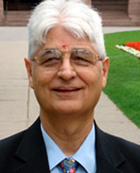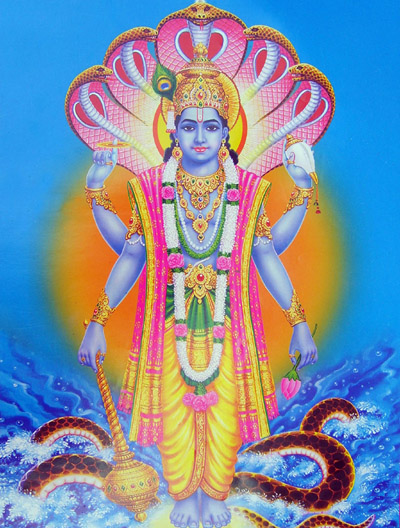Lord Vishnu

|
|
|
|
|
| Namaste, My dear children! Lord Vishnu represents the aspect of the Supreme Reality that preserves and sustains the universe. The Sanskrit root word, ‘vish’ means ȁthat which enters into,’ or ‘all pervasive’. He is generally symbolized by a human body with four arms. In His hands He carries a conch (shankha), a mace (gada), and a discus (chakra). He wears a crown, two ear-rings, a garland (mala) of flowers, and a gem around the neck. He has a blue body and wears yellow clothes. The Lord is shown reclining on a thousand-headed snake (Shesha Nag) in the milky ocean. The snake stands with its hoods open and its entire heads looking inwards at the Lord. The four arms indicate the Lord's omnipresence and omnipotence. The two front (lower) arms signify the Lord's activity in the physical world and the two rear (upper) arms signify His activity in the spiritual world. The right side of the body represents the creative activities of the mind and the intellect. The left side symbolizes the activities of the heart that is, love, kindness, and compassion.
A conch in the upper left hand indicates that the Lord communicates with His devotees with love. When blowing His conch, He reminds his devotees to live in this world with kindness and compassion towards all living beings. A chakra in His upper right hand conveys the idea that the Lord uses this weapon to protect Dharma and eliminate evil and He is dispassionate and impartial while doing this. The mace is a symbol of His energy and signifies that He sustains the manifest world by the energy that He holds in Himself. His lower right hand is depicted bestowing grace on His devotees. The mind is like an ocean, never at rest. When churned by a process of meditation and by performing austerities, it calms down and eventually gets filled with pure thoughts. Such a mind represents the milky ocean. A calm mind will be in control if its ego and the many egocentric desires as symbolized by the serpent with many heads. With absolute control over its desires, the calm mind will be able to withdraw itself from extrinsic disturbances and focus inwards and eventually discover the inner Self. This inward search of the serene ‘mind-in-control’ is illustrated by the serpent looking inwards. The crown is a symbol of the Lord's supreme power and authority. The two earrings signify the dual nature of creation, such as knowledge and ignorance, happiness and unhappiness, and pleasure and pain. The worship of Lord Vishnu is very popular among Hindus, especially among the followers of the Vaishnava tradition (Vaishnavism). Lord Vishnu is also known by other names, such as Vasudeva and Narayana. The ten incarnations of Lord Vishnu described in Hindu mythology are popular among Hindus. These incarnations reveal the help rendered by God during various stages of human evolution. The first two incarnations are in the animal form, the third one is half-human and half-animal, and the fourth and the subsequent ones are all in human form. These incarnations relate to human evolution from aquatic life to human life, and are consistent with the modern theory of evolution suggested by modern Science. Vishnu’s form emphasizes the need and value of living a righteous way of life, based on the principles of Dharma. His incarnations reveal the consequences of being unrighteous. |
|
|

*Kanayalal Raina is a Brampton based writer who contributes regularly to various Canadian publications. He is working as Executive Director at Canada Hindu Heritage Centre in Canada. An automobile Engineer and MBA (Mktg) by profession he is providing consultancy on Project Management, Financing and Marketing. |
|
|
| Copyrights ? 2007 Shehjar online and KashmirGroup.com .Any content, including but not limited to text, software, music, sound,photographs, video, graphics or other material contained may not bemodified, copied, reproduced, republished, uploaded, posted, ordistributed in any form or context without written permission. Terms & Conditions. |
